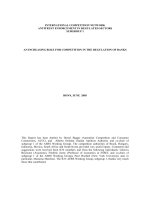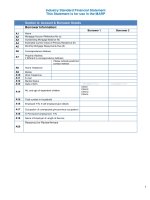Designation: C 465 – 99 - Processing Additions for Use in the Manufacture of Hydraulic Cements1 pdf
Bạn đang xem bản rút gọn của tài liệu. Xem và tải ngay bản đầy đủ của tài liệu tại đây (33.56 KB, 4 trang )
Designation: C 465 – 99
Standard Specification for
Processing Additions for Use in the Manufacture
of Hydraulic Cements
1
This standard is issued under the fixed designation C 465; the number immediately following the designation indicates the year of
original adoption or, in the case of revision, the year of last revision. A number in parentheses indicates the year of last reapproval. A
superscript epsilon (e) indicates an editorial change since the last revision or reapproval.
1. Scope
1.1 This specification pertains to the criteria and tests to be
used for determining whether a processing addition, when used
in the recommended amount at the option of the cement
producer in the manufacture of hydraulic cements, meets the
requirements as prescribed by definition in Specifications
C 150, C 1157, C 845, and C 595. The materials listed in the
following former ASTM Specifications shall be considered as
meeting the requirements of this specification:
C 150 – 62, for Portland Cement
2
C 205 – 58 T, for Portland Blast-Furnace Slag Cement
3
C 340 – 58 T, for Portland Pozzolan Cement
3
C 358 – 58, for Slag Cement
3
1.2 The following safety hazards caveat pertains only to the
test methods described in this specification. This standard does
not purport to address all of the safety concerns, if any,
associated with its use. It is the responsibility of the user of this
standard to establish appropriate safety and health practices
and determine the applicability of regulatory limitations prior
to use.
2. Referenced Documents
2.1 ASTM Standards:
C 33 Specification for Concrete Aggregates
4
C 39 Test Method for Compressive Strength of Cylindrical
Concrete Specimens
4
C 78 Test Method for Flexural Strength of Concrete (Using
Simple Beam with Third-Point Loading)
4
C 109/C 109M Test Method for Compressive Strength of
Hydraulic Cement Mortars (Using 2-in. or [50-mm] Cube
Specimens)
5
C 114 Test Methods for Chemical Analysis of Hydraulic
Cement
5
C 115 Test Method for Fineness of Portland Cement by the
Turbidimeter
5
C 138 Test Method for Unit Weight, Yield, and Air Content
(Gravimetric) of Concrete
4
C 143 Test Method for Slump of Hydraulic Cement Con-
crete
4
C 150 Specification for Portland Cement
5
C 151 Test Method for Autoclave Expansion of Portland
Cement
5
C 173 Test Method for Air Content of Freshly Mixed
Concrete by the Volumetric Method
4
C 185 Test Method for Air Content of Hydraulic Cement
Mortar
5
C 187 Test Method for Normal Consistency of Hydraulic
Cement
5
C 191 Test Method for Time of Setting of Hydraulic Ce-
ment by Vicat Needle
5
C 192 Practice for Making and Curing Concrete Test Speci-
mens in the Laboratory
4
C 204 Test Method for Fineness of Hydraulic Cement by
Air Permeability Apparatus
5
C 205 – 58T Specification for Portland Blast–Furnace Slag
Cement
3
C 226 Specification for Air-Entraining Additions for Use in
the Manufacture of Air-Entraining Portland Cement
5
C 231 Test Method for Air Content of Freshly Mixed
Concrete by the Pressure Method
4
C 293 Test Method for Flexural Strength of Concrete (Us-
ing Simple Beam with Center-Point Loading)
4
C 340 – 58T Specification for Portland Pozzolan Cement
3
C 358 – 58 Specification for Slag Cement
3
C 595 Specification for Blended Hydraulic Cements
5
C 596 Test Method for Drying Shrinkage of Mortar Con-
taining Portland Cement
5
C 617 Practice for Capping Cylindrical Concrete Speci-
mens
4
C 845 Specification for Expansive Hydraulic Cement
5
C 1157 Performance Specification for Blended Hydraulic
Cement
5
D 891 Test Methods for Specific Gravity, Apparent, of
Liquid Industrial Chemicals
6
E 203 Test Method for Water Using Karl Fischer Reagent
6
3. Materials
3.1 Cements:
1
This specification is under the jurisdiction of ASTM Committee C-1 on Cement
and is the direct responsibility of Subcommittee C01.20 on Additions.
Current edition approved Feb. 10, 1999. Published May 1999. Originally
published as C 465 – 61 T. Last previous edition C 465 – 96.
2
See 1961 Book of ASTM Standards, Part 4.
3
Discontinued, see 1958 Book of ASTM Standards, Part 4.
4
Annual Book of ASTM Standards, Vol 04.02.
5
Annual Book of ASTM Standards, Vol 04.01.
6
Annual Book of ASTM Standards, Vol 15.05.
1
AMERICAN SOCIETY FOR TESTING AND MATERIALS
100 Barr Harbor Dr., West Conshohocken, PA 19428
Reprinted from the Annual Book of ASTM Standards. Copyright ASTM
3.1.1 In cases where it is desired that the proposed addition
be accepted for general use in portland cement, tests shall be
made on cements prepared from at least five different clinkers.
As a minimum, these clinkers shall represent two Type I
cements containing not less than 9.0 % C
3
A, one Type II
cement, and two Type III cements, all conforming to Specifi-
cation C 150.
3.1.2 In cases where it is also desired that the proposed
addition be used in blended cements, the test and test proce-
dures shall be as specified with a control and an addition for
cement conforming to the appropriate Specification C 595 or
C 1157.
3.1.3 Processing additions which have been shown to meet
the requirements of this specification may also be used in
cements conforming to Specification C 845. Testing of the
addition with these special cements, where desired, shall be
done using the tests and test procedures as specified with a
control cement and a cement containing the addition, both
conforming to Specification C 845.
3.1.4 In cases where it is desired that the proposed addition
be limited in use to specific types of cement less in number
than required in 3.1.1, the tests and test procedures shall be as
specified, and at least two pairs of cements shall be prepared
from two clinkers from different plants for each type under
specific consideration.
3.1.5 In cases where it is desired that the proposed addition
be limited in use to a single plant, the tests and test procedures
shall be as specified and at least two pairs of cements shall be
prepared from clinker representing each type under specific
consideration.
3.1.6 The two companion cements to be made from any one
clinker shall be ground to the same fineness within 7 m
2
/kg
when tested in accordance with Test Method C 115 or within
13 m
2
/kg when tested in accordance with Test Method C 204,
and the SO
3
content, expressed as a percentage of the cement
mass and reported to the nearest 0.01 %, shall differ by not
more than 0.3, so as to afford comparable samples for indicat-
ing the effect of the addition on the cement. Each control
cement shall comply with all requirements in the specification
applicable to that type of cement, and shall not contain the
proposed addition when tested by the method furnished by the
producer or seller of the addition.
3.1.7 The percentage of each of the following shall be
determined for each lot of cement tested: silicon dioxide
(SiO
2
), aluminum oxide (Al
2
O
3
), ferric oxide (Fe
2
O
3
), calcium
oxide (CaO), magnesium oxide (MgO), sulfur trioxide (SO
3
),
ignition loss, insoluble residue, sodium oxide (Na
2
O), and
potassium oxide (K
2
O). There shall also be calculated the
potential percentages of the following compounds: tricalcium
silicate, dicalcium silicate, tricalcium aluminate, and tetracal-
cium aluminoferrite. Determinations for the percentage of the
addition shall be made, both on the control cements and on
those with which the addition was interground, using the
method proposed therefore by the sponsor.
3.2 Aggregates—The fine and coarse aggregates shall com-
ply with Specification C 33; the coarse aggregate shall comply
with the grading requirements for Size No. 57 or Size No. 67.
A sufficient quantity from a single lot of coarse aggregate and
from a single lot of fine aggregate shall be provided to
complete all tests. To prevent the segregation of particle sizes
in the fine aggregate, a single lot of sand sufficient for all tests
shall either ( 1) be separated on the 4.75-mm (No. 4), 1.18-mm
(No. 16), 300 µm (No. 50), and 150 µm (No. 100) sieves and
then be recombined in the required quantity for each batch; or
(2) be blended while in a damp condition, and maintained in
that condition for the duration of the tests. Under option (2),
lots of appropriate size for single mortar and concrete batches
shall be carefully split or quartered from the entire batch.
4. General Requirements
4.1 Processing additions shall conform to the respective
requirements in this specification.
4.2 The trade name, source, character of the material, and
means for the quantitative determination of the addition in the
finished cement shall be furnished by the sponsor, manufac-
turer, or supplier of the addition, and the information shall form
a part of the record of tests of the addition. If the processing
addition is a liquid, the specific gravity and percent water
content shall also be part of the record.
4.2.1 The specific gravity, run in accordance with 7.1.1 shall
be within 60.05 units of the value reported in 4.2.
4.3 Processing additions shall be evaluated by comparing
cements containing the addition to otherwise identical cements
from the same source without the addition, or containing a
processing addition which has been shown to comply with this
specification using control cements without any additions,
hereinafter designated the “control” cement.
4.4 The amount of the processing addition to be interground
with the cement for evaluation purposes shall be determined by
the sponsor of the addition.
4.4.1 The amount of the addition in the cement containing
the addition and showing compliance with the requirements of
this specification shall be determined quantitatively by means
of the quantitative determination required by 4.2.
4.4.2 The amount of addition, so determined, shall be used
to state the amount of addition that shows compliance with this
specification.
4.4.3 When tests on cements containing the addition show
compliance with the requirements of this specification, the
addition in cement may be used in any amount up to the
maximum amount showing compliance.
4.5 The cement produced for evaluation purposes with the
processing addition shall comply with the appropriate Speci-
fications C 150, C 845, C 1157M, or C 595, except that it
contains the addition under test. The effect of the addition on
the properties of the cement shall also be within the following
limits:
4.5.1 The percentage of water by mass of cement required
for normal consistency of cement containing the addition shall
not exceed that required by the corresponding control cement
by more than 1.0. For those cements not limited to a fixed
water requirement, the percentage of water by mass of cement
required for standard consistency of the mortar used for
strength determinations as described in 4.5.4 shall not be
increased by more than 2.0 by the addition over that required
for the control cement.
4.5.2 The time of setting of cement containing the addition
C 465
2
shall not vary from the time of setting of the corresponding
control cement by more than1hor50%,whichever is the
lesser.
4.5.3 The autoclave expansion of cement containing the
addition, expressed as a percentage change in length, shall be
not more than 0.10 greater than that of the corresponding
control cement.
4.5.4 The compressive strength of mortar cubes made with
cement containing the addition, in accordance with Test
Method C 109/C 109M, and tested at 1, 3, 7, and 28 days for
all types, shall be compared with strengths obtained with the
control cement at similar ages. The grand average of these
individual strength percentages shall be not less than 95 % of
the control cement values. It is required that cubes for
companion cements be made and tested on the same days, with
storage of specimens side by side in the same section of the
moist cabinet during the 24-h curing period. Retesting of
companion cements on the same, or a following, day is
required in order to provide six, rather than three, test speci-
mens for each cement and age of test.
4.5.5 The ultimate drying shrinkage (percent) of mortar
made with cement containing the addition shall not be more
than 0.025 greater than that of similar mortar made with the
corresponding control cement when tested in accordance with
Test Method C 596.
4.5.6 The compressive strength of the concrete made with
cement containing the addition shall be compared with
strengths obtained with the control cement at similar ages. The
grand average of these individual strength percentages shall be
not less than 90 % of the values for the control cement.
4.5.7 The flexural strength of concrete made with cement
containing the addition shall be compared with strengths
obtained with the control cement at similar ages. The grand
average of these individual strength percentages shall be not
less than 90 % of the values for the control cement.
4.5.8 The amount of air-entraining addition required to
produce 19 6 3 % air in the mortar test made in accordance
with Test Method C 185, with the cement containing the
addition under test, shall be not greater than 120 % of the
amount required to produce, within6 1 %, the air content
obtained with the control cement. The air-entraining addition
used shall meet the requirements of Specification C 226.
4.6 Processing additions which provide maximum effects as
grinding aids or pack set inhibitors may increase cement
flowability to a point where mill retention time is reduced
sufficiently to affect significantly the particle size distribution
of the resulting cement and its physical-chemical properties.
Since mill retention times are controllable by mechanical
means in full-scale grinding mills, the true physical-chemical
effects of the test additive may, in instances where full-scale
tests have shown mill retention time reductions to have
significant effects on the properties of the resulting cement, be
determined for acceptance purposes by making supplementary
laboratory or pilot-mill grinds.
4.7 In the event that the effect of the addition on the
properties of cement are determined on the basis of laboratory
or pilot mill grinds, this fact shall be entered in the report
specified in Section 13, and the specific tests shall be indicated.
5. Sampling Cement
5.1 Samples of the plant-ground cement shall be taken from
the product stream during grinding. Prior to the start of
sampling a given lot of cement, the mill shall have run for 4 h
or long enough to have reached equilibrium under the general
conditions that are to govern during the sampling period.
NOTE 1—Records should be kept as to the rate and continuity of feed of
the addition, the form in which the addition is used, strength of solution,
magnitude of circulating loads, mill discharge temperature, and feed rate
of clinker and gypsum. Product fineness should be determined during the
grinding immediately subsequent to sampling.
5.2 As the cement samples are taken, they shall be placed in
sealable containers which shall be sealed immediately at the
end of the sampling period. Prior to use, the samples of a given
lot of cement shall be thoroughly blended to form a uniform,
representative composite.
6. Test Methods
6.1 Determine the properties enumerated in this specifica-
tion in accordance with the test methods prescribed in Sections
7-12.
7. Tests on Liquid Processing Additions
7.1 Test the liquid processing addition, in the form normally
marketed, in accordance with the following test methods:
7.1.1 Specific Gravity—Use Test Methods D 891, Test
Method A or B.
7.1.2 Water Content—Use Test Method E 203.
8. Tests on Cement
8.1 Test cement in accordance with the following standards:
8.1.1 Chemical Analysis of Cement—Test Methods C 114.
8.1.2 Compound Composition—Specification C 150.
8.1.3 Fineness of Cement—Test Method C 115 or C 204.
8.1.4 Normal Consistency—Test Method C 187.
8.1.5 Time of Setting (Vicat)—Test Method C 191.
8.1.6 Autoclave Expansion—Test Method C 151.
8.1.7 Air Content of Mortar—Test Method C 185.
8.1.8 Compressive Strength of Mortar— Test Method
C 109/C 109M.
8.1.9 Drying Shrinkage of Mortar—Test Method C 596.
9. Concrete Mixtures
9.1 Preparation and Weighing—Prepare all materials used
in making the concrete mixtures and make all weighings as
prescribed in Practice C 192. Report the amount of mixing
water used in each batch on the basis of saturated, surface-dry
aggregates.
9.2 Proportions—Design one basic concrete mixture having
an actual cement content of 307 6 3 kg/m
3
(5176 5 lb/yd
3
),
and use in all concrete tests herein specified. Adjust the water
content of mixtures to provide concrete having a consistency
equal to a 64 6 13-mm (2
1
⁄
2
6
1
⁄
2
-in.) slump in each case.
Adjust the ratio of fine to coarse aggregate to the optimum for
concrete to be consolidated by hand rodding. Recommended
trial values for the percentage of fine aggregate in the total
aggregate, by absolute volume, are as follows:
C 465
3
Coarse Aggregate, Maximum
25.0 mm (1 in.)
Concrete Without
Entrained Air
Angular 45
Rounded 40
9.3 Mixing of Concrete—Mix the concrete in accordance
with Practice C 192 except as follows: Hand mixing will not be
permitted. The rated capacity of the machine mixer shall not be
more than twice the size of the batch used.
10. Tests on Freshly Mixed Concrete
10.1 Test samples of the freshly mixed concrete for slump in
accordance with Test Method C 143; unit weight in accordance
with Test Method C 138; and air content in accordance with
Test Method C 138, C 231, or C 173.
11. Test Specimens of Hardened Concrete
11.1 Number of Specimens—At least three specimens shall
be made for each test condition. For each cement containing an
addition and its companion control cement, make three rounds
of concrete mixed on different days. One round of mixes on a
given day shall include both the cement containing the addition
and its companion control cement. From each round, make at
least one test specimen for each test condition. If necessary, to
obtain enough concrete for all test specimens to be made in any
one round, it may be necessary to make more than one concrete
batch for each round.
11.2 Types of Specimens:
11.2.1 Compressive Strength—Compressive strength test
specimens shall be cylinders made and cured as prescribed in
Practice C 192. Cylinders shall be capped as prescribed in
Practice C 617.
11.2.2 Flexural Strength—Flexural strength test specimens
shall be beams made and cured as prescribed in Practice C 192.
12. Test on Hardened Concrete
12.1 Test the specimens on hardened concrete, as specified
in Section 11, in accordance with the following methods and at
the specified ages:
12.1.1 Compressive Strength—Test specimens in accor-
dance with Test Method C 39 at ages 3, 7, 28 days, and 3
months, except also test Type III cement at 24 h.
12.1.2 Flexural Strength—Test specimens in accordance
with Test Method C 293, or Test Method C 78, ages at 3, 7, 28
days, and 3 months, except also test Type III cement at 24 h. By
either method of test, turn the specimen on its side with respect
to its position as molded and center it on the bearing blocks.
13. Report
13.1 The report covering the results of the evaluation of a
material proposed for use as a processing addition in the
manufacture of portland cement under this specification shall
include the following information:
13.1.1 Trade name, source and character of the material, and
the amount recommended for use, together with means for
determination of the proposed addition in the finished cement,
all as furnished by the sponsor, manufacturer, or seller of the
addition,
13.1.2 If the proposed processing addition is a liquid, the
specific gravity and percent water content by mass,
13.1.3 Detailed results of all analyses and tests prescribed
by this specification, and the amount of the addition used, as
well as other pertinent information required,
13.1.4 Comparison of test results to determine compliance
with the requirements prescribed in 4.4,
13.1.5 Name and location of the laboratory or laboratories
that made the tests covered by the report,
13.1.6 Include as an appendix to the report, letters of
certification from the various cement manufacturers stating the
name of the addition, the amount used, and the type of cement
in which used, and
13.1.7 The highest amount of addition that has demon-
strated compliance with the specification in a particular type of
cement (see 4.4.3).
14. Manufacturer’s Certification of Liquid Processing
Aids
14.1 Upon request of the purchaser in the contract or order,
a manufacturer’s report shall be furnished at the time of
shipment stating the water content and specific gravity of the
samples of the material taken during production or transfer and
certifying that the specific gravity value is within the specified
limits of the originally qualified product and that the product
meets the requirements of this Specification.
15. Keywords
15.1 additions; hydraulic cements; processing
The American Society for Testing and Materials takes no position respecting the validity of any patent rights asserted in connection
with any item mentioned in this standard. Users of this standard are expressly advised that determination of the validity of any such
patent rights, and the risk of infringement of such rights, are entirely their own responsibility.
This standard is subject to revision at any time by the responsible technical committee and must be reviewed every five years and
if not revised, either reapproved or withdrawn. Your comments are invited either for revision of this standard or for additional standards
and should be addressed to ASTM Headquarters. Your comments will receive careful consideration at a meeting of the responsible
technical committee, which you may attend. If you feel that your comments have not received a fair hearing you should make your
views known to the ASTM Committee on Standards, 100 Barr Harbor Drive, West Conshohocken, PA 19428.
C 465
4









